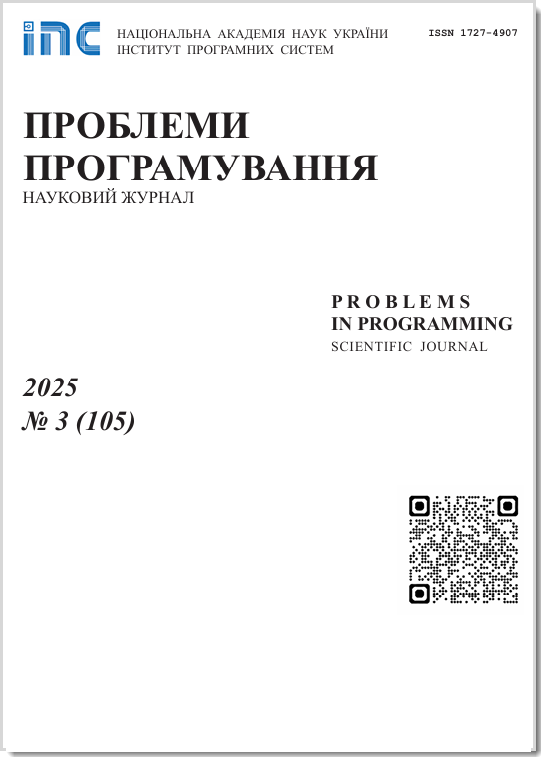Development of the local navigation algorithm of the agricultural UAVS flock during swarm movement
Abstract
Every year, the scope of unmanned aerial vehicles use is growing, and the amount of such applications is expanding. To enhance efficiency, the focus of development is shifting from individual unmanned aerial vehicles to utilizing swarms for various applications such as agricultural surveys, irrigation, etc. The purpose of this work is to develop an algorithm for building a local positioning system for a swarm of unmanned aerial vehicles to maintain a stable structure during the swarm movement while performing its tasks in two-dimensional and three-dimensional settings. At the same time, it should be assumed that the swarm is controlled by one operator, regardless of the number of swarm elements. An additional limitation of the developed algorithm should be the prevention of potential collisions of unmanned aerial vehicles during aerial maneuvers. As part of the work, the task of forming and maintaining the structure and configuration of an agricultural unmanned aerial vehicles flock in two-dimensional and three-dimensional settings was set. The formalization of the given task has been completed. Considered possible methods of mapping the graph formed by an unmanned aerial vehicles swarm into two-dimensional Euclidean space by the forming a basic triangle method to create a relative coordinate system. To determine the coordinates of the remaining graph vertices on the plane and correspondingly increase the accuracy of local positioning, the multilateration method is used. Considered simplified options – application of the trilateration and triangulation algorithms. For the problem in a three-dimensional setting, the possibility of applying the multidimensional scaling algorithm using the methods of multidimensional scaling/reduction of dimensions is considered. The developed practical implementation of the created algorithm showed its efficiency during practical experiments, allowing to determine the local positioning of elements of a swarm containing from three to twenty elements.
Prombles in programming 2024; 2-3: 155-162
Keywords
Full Text:
PDF (Українська)References
Y. Zhou, R. Bin, W. Wei, UAV swarm intelligence: Recent advances and future trends, Ieee Access 8 (2020): 183856-183878. CrossRef
M. Campion, R. Prakash, F. Saleh, UAV swarm communication and control architectures: a review, Journal of Unmanned Vehicle Systems, 2018. 7.2. pp. 93-106. CrossRef
Modern methods of digital monitoring in crop production: monography. Zozylya et al. K.: Taras Shevchenko National University of Kyiv, 2023. 254 p.
X. Wang, G. Chen, H. Gong, J. Jiang, UAV swarm autonomous control based on Internet of Things and artificial intelligence algorithms, Journal of Intelligent & Fuzzy Systems, 2021. 40(4). pp. 7121-7133. CrossRef
V. Roberge, M. Tarbouchi, G. Labonté, Comparison of parallel genetic algorithm and particle swarm optimization for real-time UAV path planning. IEEE Transactions on industrial informatics, 2012. 9(1). pp. 132-141. CrossRef
S. Shao, Y. Peng, C. He, Y. Du, Efficient path planning for UAV formation via comprehensively improved particle swarm optimization. ISA transactions, 2020. 97. pp. 415-430. CrossRef
M. D. Phung, Q. P. Ha, Safetyenhanced UAV path planning with spherical vector-based particle swarm optimization. Applied Soft Computing, 2021. 107. pp. 107376. CrossRef
D. Sikeridis, E. EleniTsiropoulou, M. Devetsikiotis, S. Papavassiliou, Selfadaptive energy efficient operation in UAV-assisted public safety networks, 2018 IEEE 19th international workshop on signal processing advances in wireless communications (SPAWC) 2018, June, IEEE. 2018. pp. 1-5. CrossRef
S. N. Othman, Node positioning in zigbee network using trilateration method based on the received signal strength indicator (RSSI). European Journal of Scientific Research, 2010. 46(1). pp. 048-061.
F. He, T. Zhou, W. Xiong, S. M.Hasheminnasab, A. Habib, Automated aerial triangulation for UAV-based mapping, Remote Sensing, 10(12). 2018, p. 1952. CrossRef
B. Yang, E. Yang, L. Yu, A. Loeliger, High-precision UWB-based localisation for UAV in extremely confined environments, IEEE Sensors Journal, 2021. 22(1). pp. 1020-1029. CrossRef
R. Chen, B. Yang, W Zhang, Distributed and collaborative localization for swarming UAVs, IEEE Internet of Things Journal, 2020. 8(6). pp. 5062-5074. CrossRef
M. Ogurtsov, V. Korolyov, O. Khodzinskyi, Improving the Productivity of UAV Operations Based on Granular Computing and Fuzzy Sets, 2021 IEEE 6th International Conference on Actual Problems of Unmanned Aerial Vehicles Development (APUAVD)19-21 Oct. 2021. pp. 33-36. CrossRef
V.P. Horbulin, L.F. Hulianytskyi, I.V. Sergienko, Planning of Logistics Missions of the "UAV+Vehicle" Hybrid Systems, Cybernetics and System Analysis, 59, 2023. pp. 733-742. CrossRef
DOI: https://doi.org/10.15407/pp2024.02-03.155
Refbacks
- There are currently no refbacks.









